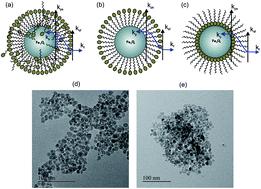当前位置:
X-MOL 学术
›
Nanoscale Adv.
›
论文详情
Our official English website, www.x-mol.net, welcomes your
feedback! (Note: you will need to create a separate account there.)
Mechanistic insights into surface contribution towards heat transfer in a nanofluid
Nanoscale Advances ( IF 4.6 ) Pub Date : 2020-06-10 , DOI: 10.1039/d0na00452a Ajit Singh 1 , Ramanujam Lenin 1 , Naimat Kalim Bari 1 , Chirodeep Bakli 2 , Chandan Bera 1
Nanoscale Advances ( IF 4.6 ) Pub Date : 2020-06-10 , DOI: 10.1039/d0na00452a Ajit Singh 1 , Ramanujam Lenin 1 , Naimat Kalim Bari 1 , Chirodeep Bakli 2 , Chandan Bera 1
Affiliation

|
Nanofluids play a very important role in thermal management and heat exchange processes and for a stable nanofluid, a surfactant is a salient material. There are many contrasting reports on the thermal conductivity of nanofluids and the associated heat transport mechanism in nanofluids. In this article, four different types of nanoparticles are synthesized using citric acid and oleic acid as surfactants, followed by the assessment of their thermal conductivities. For a nanofluid of 3 wt% nanoparticles, coated with citric acid in water 67% reduction in thermal conductivity is observed, and on the other hand a 4% enhancement in thermal conductivity is observed for oleic acid-coated nanoparticles in toluene. This anomaly in the thermal transport behaviour of the nanofluid can be related to the surface properties of nanoparticles and the polarity of the base fluid. Theoretical calculation based on molecular dynamics simulations shows that the reduction in long-range interaction and fluid structuration reduce the thermal conductivity in a polar fluid with a polar surfactant coated nanoparticle.
中文翻译:

对纳米流体中表面对传热的贡献的机理见解
纳米流体在热管理和热交换过程中起着非常重要的作用,对于稳定的纳米流体,表面活性剂是一种显着的材料。关于纳米流体的热导率和纳米流体中相关的热传输机制有许多不同的报道。在本文中,使用柠檬酸和油酸作为表面活性剂合成了四种不同类型的纳米粒子,然后评估了它们的热导率。对于 3 wt% 纳米粒子的纳米流体,在水中涂有柠檬酸,观察到热导率降低 67%,另一方面,在甲苯中观察到涂有油酸的纳米粒子的热导率提高 4%。纳米流体的热传输行为的这种异常可能与纳米粒子的表面性质和基础流体的极性有关。基于分子动力学模拟的理论计算表明,长程相互作用和流体结构的减少会降低具有极性表面活性剂涂层纳米颗粒的极性流体的热导率。
更新日期:2020-08-11
中文翻译:

对纳米流体中表面对传热的贡献的机理见解
纳米流体在热管理和热交换过程中起着非常重要的作用,对于稳定的纳米流体,表面活性剂是一种显着的材料。关于纳米流体的热导率和纳米流体中相关的热传输机制有许多不同的报道。在本文中,使用柠檬酸和油酸作为表面活性剂合成了四种不同类型的纳米粒子,然后评估了它们的热导率。对于 3 wt% 纳米粒子的纳米流体,在水中涂有柠檬酸,观察到热导率降低 67%,另一方面,在甲苯中观察到涂有油酸的纳米粒子的热导率提高 4%。纳米流体的热传输行为的这种异常可能与纳米粒子的表面性质和基础流体的极性有关。基于分子动力学模拟的理论计算表明,长程相互作用和流体结构的减少会降低具有极性表面活性剂涂层纳米颗粒的极性流体的热导率。











































 京公网安备 11010802027423号
京公网安备 11010802027423号